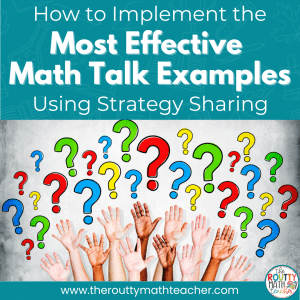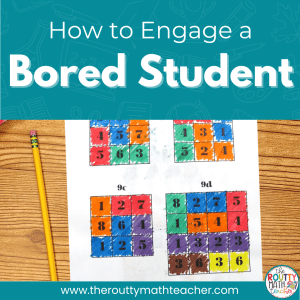Math Talk Examples: Strategy Sharing
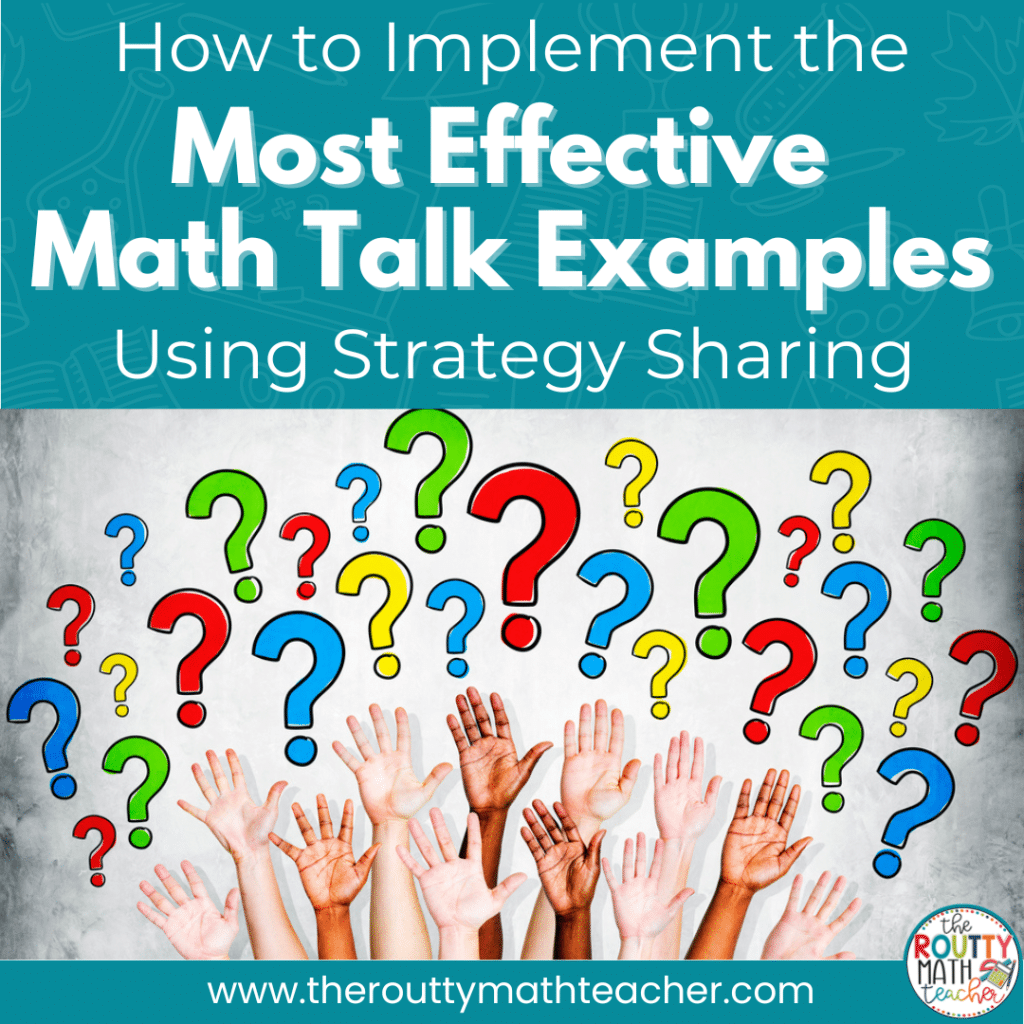
One of the quickest ways to get your students talking is to share solution strategies to a problem. In this post, I share one of my favorite math talk examples– open strategy sharing.
Me: I’m going to display our dot image for today. You have three seconds to determine the number of dots in the picture. (I display the image on the screen for three seconds and then cover the image under the doc camera.)
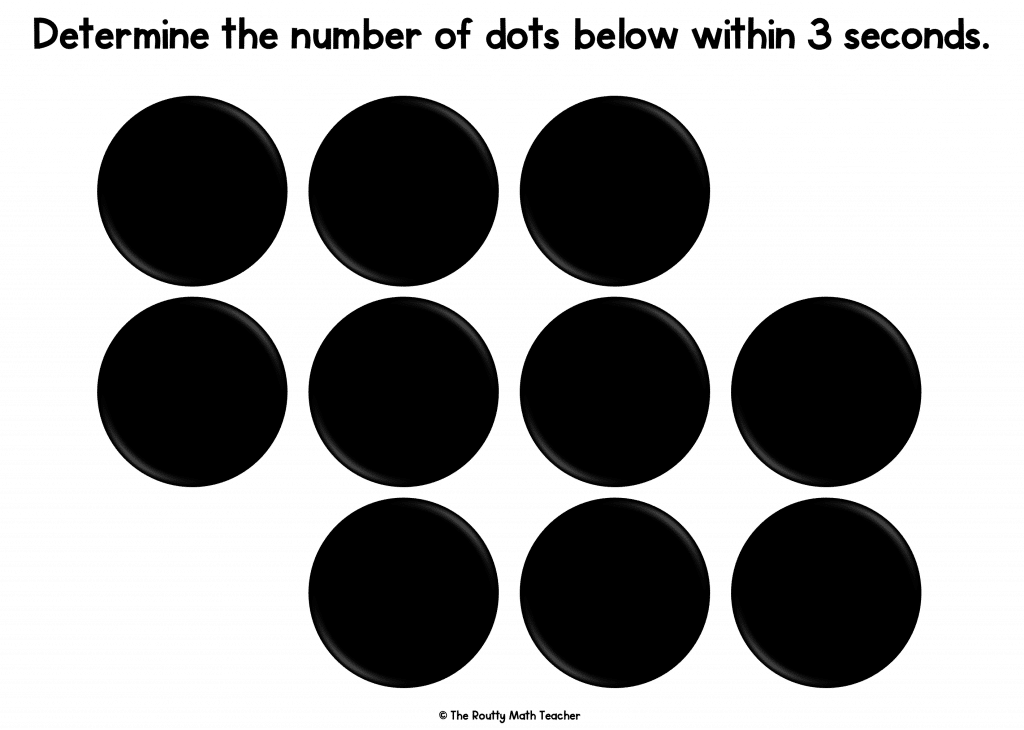
Me: Raise your hand if you would like to share the number of dots you saw. (I begin calling on students. As students give their numbers, I record them on the blank paper covering the dot image. I place a check mark next to repeat responses.)
Me: I see several people counted 10 dots. Would anyone like to share the strategy you used to count them? (As I call on students to share their strategy, I revoice their thinking and demonstrate it using the dot image.)
Student 1: I saw three rows of four and subtracted the two that were missing.
Me: So you saw three rows of four (3 x 4) and subtracted two. (I record (3 x 4) – 2 on the dot paper.)
Student 2: I saw one group of six in the middle and two groups of two on each side.
Me: So you saw six plus two groups of two. (I record 6 + (2 x 2) on the dot paper.)
Student 3: I saw the row of four in the middle and two groups of three on the top and the bottom.
Me: So you saw four plus two groups of three. (I record 4 + (2 x 3) on the dot paper.)
Me: Let’s think about the strategies that were shared. What’s the same about them? How are they different?
—
How I Started Using Math Talk in the Classroom
As a lover of problem solving, my students were accustomed to sharing their strategies when we completed problem solving tasks; however, it’s not something we did all the time. At best, we were able to complete a lengthy problem solving task once a week or so.
I knew this wasn’t enough, so when I started learning more about teaching students to use flexible strategies to build numerical reasoning skills, I decided this would be a great way to strengthen students’ mathematical communication skills on a daily basis.
After a lot of trial and error, I found I really liked using pictures, like the ones from Greg Tang’s books, and dot images to help students build numerical fluency skills and flexibility with numbers.
Over time, students became more confident with their responses and more inventive in the strategies they used. It also gave me the chance to begin connecting their numerical phrases with algebraic expressions and symbols, a skill I knew they would need in later years.
Math Talk Examples: The Power in Open Strategy Sharing
There are many math talk examples teachers can use in the classroom; however, over the years, I have discovered the open strategy sharing idea is an easy entry point and is effective for students.
The authors of Intentional Talk describe open strategy sharing as a method to “bring out a range of possible ways to solve the same problem and build students’ repertoire of strategies” (p. 18).
You’re probably thinking, “Isn’t this something we do already?” The answer to this question is yes; however, the open strategy sharing structure as described in the book provides some additional structure and intentionality for teachers.
Read on to explore how to use math talk strategies in the classroom.
How to Implement an Effective Open Strategy Sharing Session
As with any effective learning experience, it is essential to create a plan for using math talk in the classroom.
During open strategy sharing, students discuss the strategies they used to solve a particular problem. Students then listen to each other and share their ideas. The teacher probes students with questions related to how they determined the solution and students justify why they selected a particular solution path. During the discussion, the teacher highlights a variety of strategies and emphasizes the similarities and differences among them.
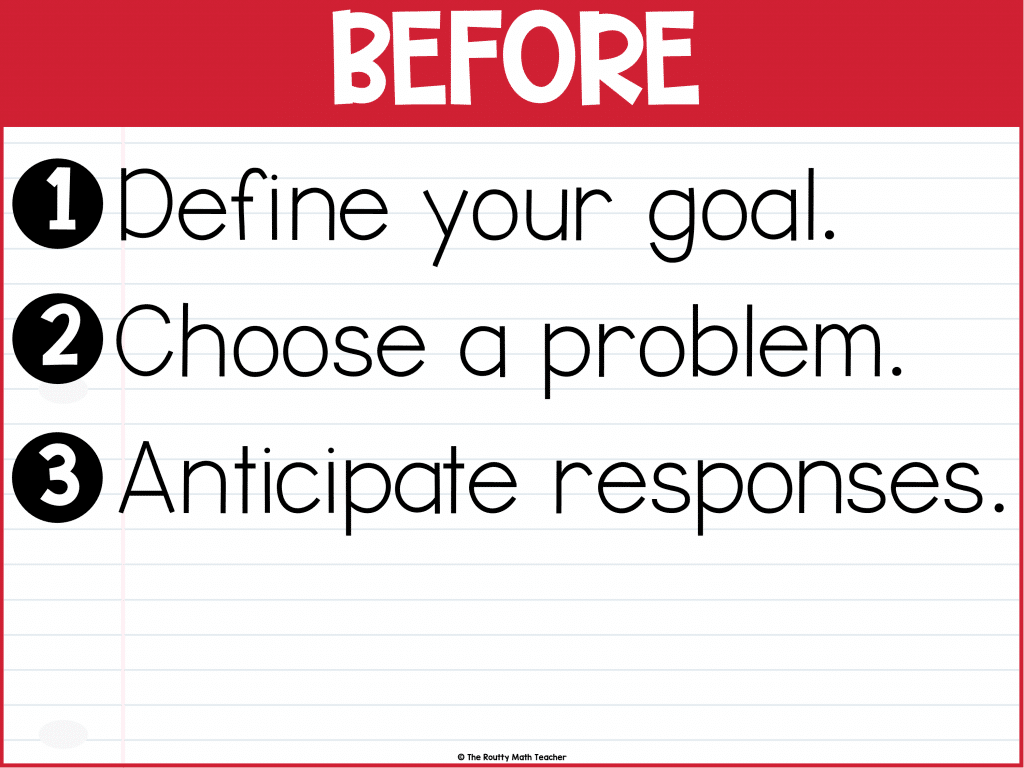
What to Do Before the Discussion
- Define your goal: Think about what you hope to accomplish through the math talk session? Some math talk goals include:
- Listen and compare methods
- Look for the most efficient way to solve a problem
- Generate explanations for why a particular solution works
- Examine why one solution is correct and why another is not
- Choose a Problem: The problem you choose to use with your students depends on your goal.
- If you want to highlight a variety of strategies that can be used to solve a problem, then choose a problem with multiple solution strategies.
- If you examine why one solution is correct and another incorrect, then choose a problem where students frequently make missteps in their solution strategies.
- Anticipate Student Responses: After selecting a problem, you will want to think about how students might respond to the problem and create a plan to address any misconceptions that threaten student understanding. In addition, if there is an obscure solution you believe students may overlook, then plant the seed with a student group or be prepared to introduce the strategy yourself. For example, you can say, “Last year, when I challenged the class with this problem, someone solved the problem like this (show the strategy). How does this strategy compare to the others we saw today?”
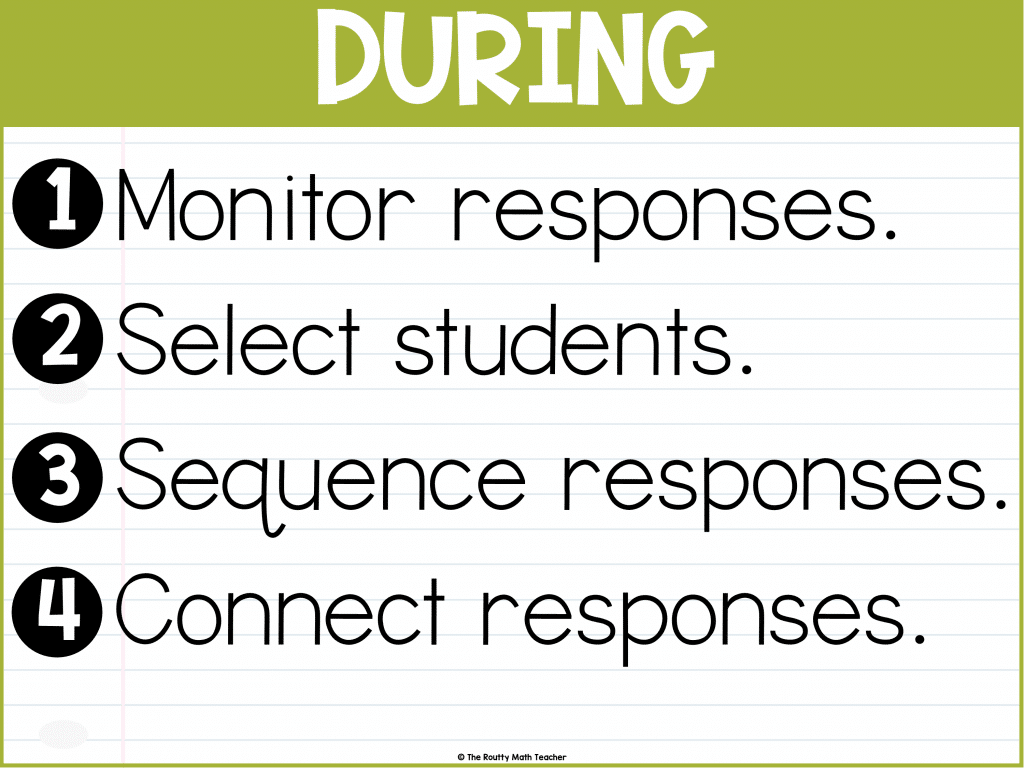
What to Do During the Discussion
- Monitor Student Responses: During this time, observe the group discussions and make notes about the solution strategies. Also, note any other areas of concern.
- Select Students to Present: Based on your observations, determine which student’s solution strategies to highlight that will accomplish your goal. For example, if you want to emphasize a variety of strategies to solve a particular problem, select solutions that vary from one another.
- Sequence Student Responses: This is critical! You will want to consider the order in which to present the solution strategies. The order you select should maximize the students’ learning experience. For example, beginning with the most widely used strategy and then moving to more abstract strategies may draw students’ attention to new methods. Similarly, beginning with the more concrete strategies will give students the opportunity to move from a more concrete to an abstract understanding.
- Connect Student Responses: Connecting solutions is the most important part of open strategy sharing. In the beginning, students may need support to make appropriate connections. For example, if you sequence the presentations from less sophisticated to more sophisticated, you can have students discuss the similarities and differences between the solutions. You can also discuss efficiency. Which process is more efficient?
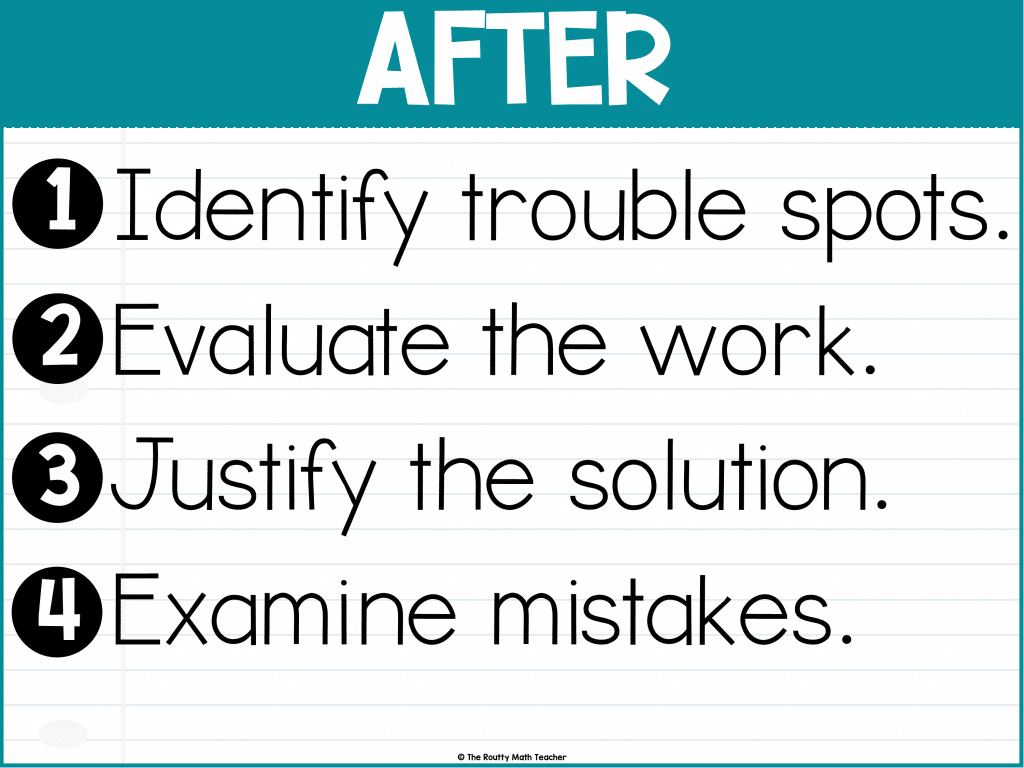
What to Do After the Discussion
After reviewing the students’ solutions and listening to their presentations, use the information you gathered to determine the next steps. The following activities will help extend and deepen the students’ understanding.
- Look for Areas of Concern: Review the solutions for common errors or misconceptions to gather input for follow-up lessons.
- Check for Reasonableness: After the discussion, ask each group to develop a method to check their strategy for reasonableness. Alternately, choose a specific solution and ask students to determine a method to check for reasonableness.
- Justify the Solution: Students should be able to explain why a specific solution strategy leads to the correct answer. For this activity, have students use pictures, numbers, and words to make sense of a solution strategy and explain why it works.
- Look for What Went Wrong: Examining mistakes is a powerful activity for students! You may want to consider using one of the solution strategies that did not lead to the correct answer (if available) and explore where the solution went wrong. After determining the misstep, allow students the opportunity to complete the remainder of the solution strategy. If you don’t have an incorrect solution strategy to use, create one yourself and say, “What if someone had done (show the strategy)?” Then, allow students to discuss the mistake(s).
Getting Started
Using math talk in the classroom is an essential part of effective mathematics instruction. Open strategy sharing is only one of many math talk examples. With regular use, it will strengthen student understanding and build powerful math students.
Check out this blog post and download my Math Talk Moves poster using the form below.
Sound Off!
What math talk strategies do you use in the classroom? Respond in the comments section below.
References
Kazemi, E. & Hintz, A. (2014). Intentional talk: How to structure and lead productive mathematical discussions. Stenhouse Publishers: Portland, Maine.




